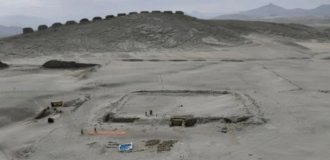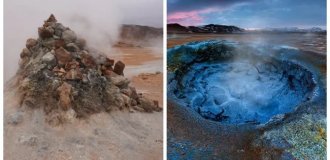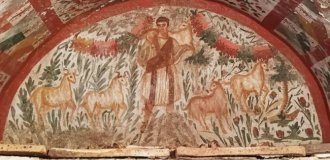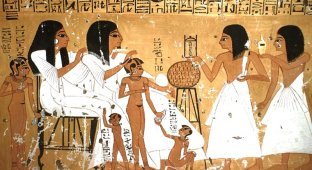How people imagined the Earth in ancient times (12 photos)
Since ancient times, people have been excitedly watching the starry sky, trying to unravel the mystery of the structure of the surrounding world. Today, humanity knows much more about how the Universe works, what elements and objects it consists of. But ancient ideas about the Universe differed significantly from modern scientific views.

Ancient Greeks
Imagined the Earth to be flat. This opinion was held, for example, by the ancient Greek philosopher Thales of Miletus, who lived in the 6th century BC. He considered the Earth to be a flat disk surrounded by a sea inaccessible to humans, from which the stars emerge every evening and into which they set every morning. Every morning, the sun god Helios (later identified with Apollo) rose from the eastern sea in a golden chariot and made his way across the sky.

Egypt
The world in the minds of the ancient Egyptians: below is the Earth, above it is the goddess of the sky; to the left and to the right is the ship of the Sun god, showing the path of the Sun across the sky from sunrise to sunset.

India
The ancient Indians imagined the Earth as a hemisphere supported by four elephants. The elephants stood on a huge turtle that swam in the sea of milk. All these animals were wrapped in rings by the black cobra Sheshu, and her thousands of heads propped up the Universe.

Babylon. Today's Iraq... in those parts
The inhabitants of Babylon imagined the Earth as a mountain, on the western slope of which Babylonia was located. They knew that to the south of Babylon there was a sea, and to the east there were mountains that they did not dare cross. That’s why it seemed to them that Babylonia was located on the western slope of the “world” mountain. This mountain is surrounded by the sea, and on the sea, like an overturned bowl, rests the solid sky - the heavenly world, where, like on Earth, there is land, water and air. The celestial land is the belt of the 12 constellations of the Zodiac: Aries, Taurus, Gemini, Cancer, Leo, Virgo, Libra, Scorpio, Sagittarius, Capricorn, Aquarius, Pisces. The Sun appears in each constellation for about a month each year. The Sun, Moon and five planets move along this belt of land. Under the Earth there is an abyss - hell, where the souls of the dead descend. At night, the Sun passes through this underground from the western edge of the Earth to the eastern, so that in the morning it will again begin its daily journey across the sky. Watching the Sun set over the sea horizon, people thought that it went into the sea and also rose from the sea. Thus, the ancient Babylonians’ ideas about the Earth were based on observations of natural phenomena, but limited knowledge did not allow them to be correctly explained.

Greeks.
The famous ancient Greek scientist Aristotle (IV century BC) was the first to use observations of lunar eclipses to prove the sphericity of the Earth. Before him, by the way, Pythagoras of Samos put forward this theory (in the 6th century BC)
Here are three facts:
* the shadow of the Earth falling on the full Moon is always round. During eclipses, the Earth is turned to the Moon in different directions. But only the ball always casts a round shadow.
** Ships, moving away from the observer into the sea, are not gradually lost from sight due to the long distance, but almost instantly seem to “sink”, disappearing beyond the horizon.
*** some stars can only be seen from certain parts of the Earth, but to other observers they are never visible.

Claudius Ptolemy (2nd century AD) - ancient Greek astronomer, mathematician, optician, music theorist and geographer. In the period from 127 to 151 he lived in Alexandria, where he conducted astronomical observations. He continued Aristotle's teaching regarding the sphericity of the Earth.
He created his geocentric system of the universe and taught that all celestial bodies move around the Earth in empty cosmic space.
Subsequently, the Ptolemaic system was recognized by the Christian Church.

Finally, the outstanding astronomer of the ancient world, Aristarchus of Samos (late 4th - first half of the 3rd century BC) expressed the idea that it is not the Sun together with the planets that moves around the Earth, but the Earth and all the planets revolve around the Sun. However, he had very little evidence at his disposal.
And about 1,700 years passed before the Polish scientist Copernicus managed to prove this.

Copernicus
His hypotheses refuted the theory of the ancient Greek scientist Ptolemy, which had existed for almost 1,500 years. According to this theory, at center B
In the universe, the Earth rested motionless, and all the planets, including the Sun, revolved around it.
Although the teachings of Ptolemy could not explain many astronomical phenomena, the church for many centuries maintained the inviolability of this theory, since it completely suited it. But Copernicus could not be content with hypotheses alone; he needed more compelling arguments, but it was very difficult to prove the correctness of his theory in practice in those days: there were no telescopes, and astronomical instruments were primitive. The scientist, observing the sky, drew conclusions about the incorrectness of Ptolemy’s theory, and with the help of mathematical calculations he convincingly proved that all planets, including the Earth, revolve around the Sun.
The church could not accept the teachings of Copernicus, since it destroyed the theory of the divine origin of the Universe. Nicolaus Copernicus outlined the result of his 40 years of research in the work “On the Rotation of the Celestial Spheres,” which, thanks to the efforts of his student Joachim Rheticus and like-minded person Tiedemann Giese, was published in Nuremberg in May 1543.
The scientist himself was already ill at that time: he suffered a stroke, as a result of which the right half of his body was paralyzed. On May 24, 1543, after another hemorrhage, the great Polish astronomer died. They say that already on his deathbed, Copernicus still managed to see his book printed.
In general: But still she spins!

Italian. Galileo Galilei, complete: Galileo di Vincenzo Bonaiuti de Galilei
Creates his own tube and calls it a telescope! By the way, I copied it from the Dutch. It seems that the invention didn’t help them, unlike Vincenzo, or they didn’t have enough brains)
After careful measurements and calculations, Galileo's telescope turns out to be incredibly accurate (for those times), but it also allows Galileo to make a lot of discoveries.
Galileo made his very first discovery after a detailed study of the surface of the Moon. He not only proved, but also described in detail the mountains that are on the surface of the Moon.
Galileo's second discovery was the Milky Way. The scientist proved that it consists of a cluster of many stars. In addition to such a cluster of stars, the scientist suggested that there are other galaxies in the world that can be located in different planes of the vast Universe.
The third most significant and significant discovery was the 4 satellites of Jupiter.
With his observations, Galileo simply and accurately proved that any cosmic body can rotate around other celestial bodies and not only around the Earth. The great astronomer examined and described in detail the spots on the Sun, of course, other people saw them, but no one was able to adequately and correctly describe them until Galileo Galilei did it.

In addition to observing the Moon, Galileo also revealed to the world the phases of the planet Venus. In his writings, he compared the phases of Venus with the phases of the Moon. All such important and significant observations boiled down to the fact that the Earth, along with other planets of our galaxy, revolves around the Sun.
Galileo described all his observations and discoveries in a scientific book called “Star Messenger”. It was after reading this book and the discoveries that Galileo made that almost all monarchs in Europe demanded the purchase of a telescope. The scientist himself gave several of his inventions to his patrons.
Of course, compared to current telescopes like Hubble, the Galileo telescope looks uncomplicated and simple. If you think about the fact that such a primitive device allowed one person to make a huge number of discoveries, then it becomes clear that it doesn’t matter whether a person’s device is supernew or old - the main thing is that the person looking into it has an extraordinary mind.

And by the way, they burned Giordano Bruno. This is such an irony...























